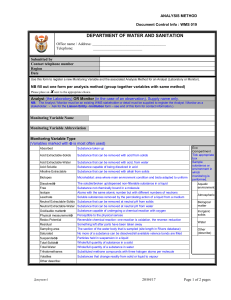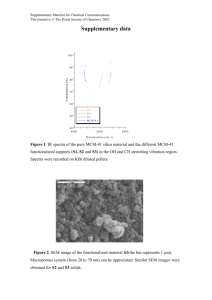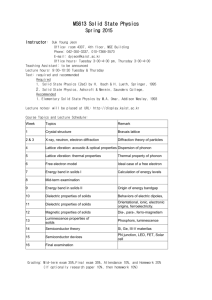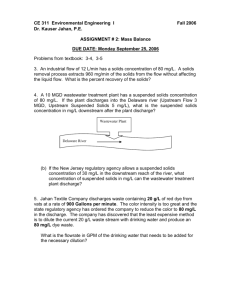TNE2027 - Tomato Land
advertisement
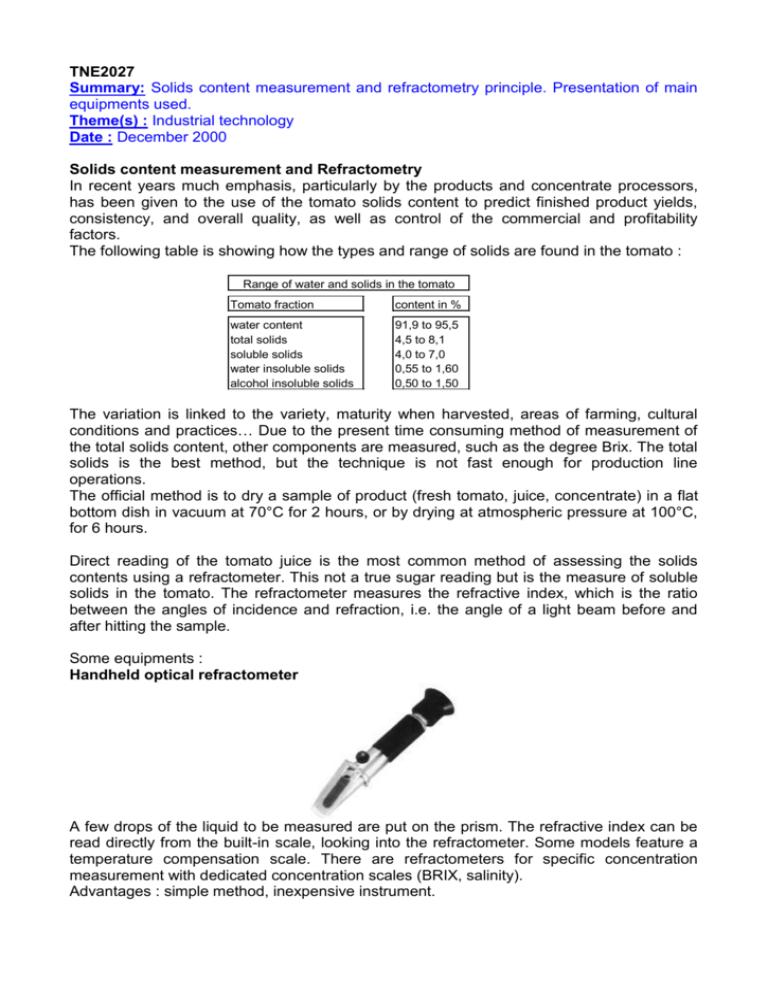
TNE2027 Summary: Solids content measurement and refractometry principle. Presentation of main equipments used. Theme(s) : Industrial technology Date : December 2000 Solids content measurement and Refractometry In recent years much emphasis, particularly by the products and concentrate processors, has been given to the use of the tomato solids content to predict finished product yields, consistency, and overall quality, as well as control of the commercial and profitability factors. The following table is showing how the types and range of solids are found in the tomato : Range of water and solids in the tomato Tomato fraction content in % water content total solids soluble solids water insoluble solids alcohol insoluble solids 91,9 to 95,5 4,5 to 8,1 4,0 to 7,0 0,55 to 1,60 0,50 to 1,50 The variation is linked to the variety, maturity when harvested, areas of farming, cultural conditions and practices… Due to the present time consuming method of measurement of the total solids content, other components are measured, such as the degree Brix. The total solids is the best method, but the technique is not fast enough for production line operations. The official method is to dry a sample of product (fresh tomato, juice, concentrate) in a flat bottom dish in vacuum at 70°C for 2 hours, or by drying at atmospheric pressure at 100°C, for 6 hours. Direct reading of the tomato juice is the most common method of assessing the solids contents using a refractometer. This not a true sugar reading but is the measure of soluble solids in the tomato. The refractometer measures the refractive index, which is the ratio between the angles of incidence and refraction, i.e. the angle of a light beam before and after hitting the sample. Some equipments : Handheld optical refractometer A few drops of the liquid to be measured are put on the prism. The refractive index can be read directly from the built-in scale, looking into the refractometer. Some models feature a temperature compensation scale. There are refractometers for specific concentration measurement with dedicated concentration scales (BRIX, salinity). Advantages : simple method, inexpensive instrument. Disadvantages : small measuring range (which requires several refractometers to cover a wide range of Brix values), no thermostating, operator dependent readings (limited accuracy), no measurement protocol. Applications : quick control of a rough value, especially for Brix measurements. Benchtop ABBE refractometer A few drops of the liquid to be measured are put on the prism. The refractive index can be read directly from the built-in scale, looking into the refractometer. Connection to an external water bath allows thermostating required for accurate refractive index measurements. Some models use natural light, the most advanced a light source with defined wave length. Advantages : relatively inexpensive instrument. Disadvantages : long and difficult thermostating, operator dependent readings, no measurement protocol (not suitable for GMP), tedious calibration. Applications : raw material and production control. Digital refractometer The latest in refractive index measurement. A high resolution optical sensor measures the total reflection of a light beam emitted by a special LED light source after hitting the sample. This total reflection is converted into refractive index, BRIX, HFCS or user defined concentrations. A built-in Peltier thermostat controls the temperature (no water bath required). Advantages : very high accuracy, operator independent readings, automation (sample changer, computer) Disadvantages : relatively expensive. Applications : high accuracy measurements, raw material and production control. Tomato Dry Matter Diagram SUCROSE (soluble) 1% AMINO ACIDS (soluble) 2% FRUCTOSE (soluble) 25% DIVERS 3% MALIC ACID (soluble) 4% GLUCOSE (soluble) 22% HEMICELLULOSE CELLULOSE (insol.) 5% SUB PECTICS (insol.) 7% PROTEINS (insol.) 7% MINERALS (soluble) 11% CITRIC ACID (soluble) 9% Despite the inappropriate confusion between these measurements, many processors and buyers use the degree Brix to indicate the solids contents of the tomato products. Another portion of the total solids content of the tomato, as important as the Brix value, is the water insoluble solids content. This measurement is the difference between the Total solids content and the Brix value. (Sources : Tomato production, Processing and Technology, 1992 Tomato News)



